Guerrero

Pronunciation: geh-REH-roh.
Origin of state name: Honors the memory of Vicente Guerrero Saldaña (1783–1831) who took part in the independence movement.
Capital: Chilpancingo de los Bravo (typically called Chilpancingo).
Entered country: 1849.
Coat of Arms: The upper section is formed by a headdress with eleven colored feathers. The central blue background represents the sky and water. A warrior displays a mace (clublike weapon) horizontally with his right hand. In his left hand, he holds a shield, which is a Náhuatl (language of the Aztec Indians) symbol for power, decorated in red, green, purple, and yellow. The warrior wears a tiger skin with spots denoting the stars that represent Tezcatlipoca, Lord of the Night. In the lower part of the shield, nine feathers form a fan.
Holidays: Año Nuevo (New Year's Day—January 1); Día de la Constitución (Constitution Day—February 5); Benito Juárez's birthday (March 21); Primero de Mayo (Labor Day—May 1); Revolution Day, 1910 (November 20); and Navidad (Christmas—December 25).
Flag: There is no official flag.
Time: 6 AM = noon Greenwich Mean Time (GMT).
1 Location and Size
Guerrero is located in southern Mexico. It covers an area of 64,586 square kilometers (24,937 square miles), slightly larger than the US state of West Virginia. It is bordered on the north by the Mexican states of Michoacán, México, and Morelos; on the east by the states of Puebla and Oaxaca; and on the south by the Pacific Ocean. Guerrero has seventy-six municipalities. The capital, Chilpancingo de los Bravos (typically called Chilpancingo), is located approximately in the center of the state.
Guerrero is one of the most mountainous states in Mexico. Its mountain ranges ( sierras ) include the Sierra Madre del Sur and the Sierras del Norte. Between these two mountain ranges is the warm and dry region surrounding the Río Balsas (Balsas River). The state is also known for its coastal plain, which stretches along the coastline of the Pacific Ocean. Agriculture and livestock thrive in the interior valleys.
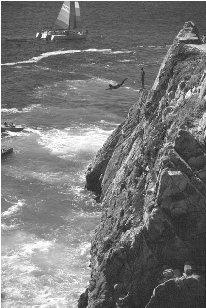
Acapulco was one of Mexico's first resort towns.
The basin of the Río Balsas is formed by small rivers (tributaries) that rise in the Sierras del Norte and in the Sierra Madre del Sur and eventually flow into the Río Balsas. Acapulco, established in 1550 by Spanish settlers, is one of Mexico's oldest resorts. The natural Pacific coast harbor there is surrounded by cliffs. The El Veladero National Park protects the natural areas in the mountains around Acapulco.
2 Climate
Acapulco on the coast is generally hot and fairly humid. Most of the rain falls from June to October, when there are light showers each day, with occasional tropical storms. A damaging hurricane, Hurricane Pauline, caused several hundred deaths when it struck Guerrero and Oaxaca in October 1997. The winter months (December to April) are slightly cooler with less rainfall. The average winter temperature ranges from 25° c to 27° c (77° f to 81° f ). The average summer temperature ranges from 28° c to 29° c (82° f to 84° f ).
3 Plants and Animals
There are tropical forests and mangroves along the Pacific Ocean. Oak and pine forests are found in the mountain areas. The valley around the Río Balsas has small, scrubby shrubs. Exotic tropical trees like the amate (umbrella plant), organ cactus, and many varieties of palm trees are common.
Native animals include iguanas and other lizards, snakes, rabbits, and coyotes.
Animals that are endangered or whose habitat is threatened by development include jaguar, eagle, turtle, and iguana. There are many lizard and snake species, and rabbits and coyotes are plentiful.
4 Environmental Protection
Acapulco and Ixtapa are two of Mexico's most important tourist sites. The El Veladero National Park, in the mountain range that surrounds Acapulco Bay, is home to many tropical trees and some wildlife.
5 Population, Ethnic Groups, Languages
Guerrero had a total population of 3,079,649 in 2000; of the total, 1,491,287
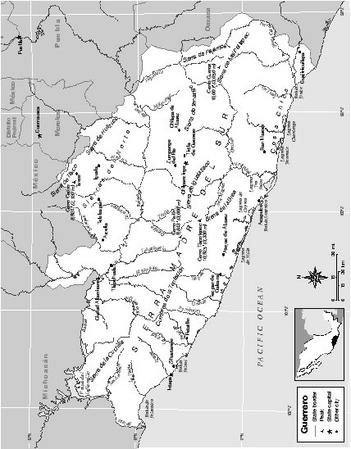
6 Religions
According to the 2000 census, 77% of the population, or 2.4 million people, were Roman Catholic; about 4%, or 117,511 people, were Protestant. That year there were also 43,320 Jehovah's Witnesses and 875 Jews. Over 100,000 people reported no religion.
7 Transportation
There are 8,146 kilometers (5,091 miles) of paved roads and 94 kilometers (58 miles) of railroad in the state. A four-lane highway connects Mexico City and Acapulco. International airports in Zihuatanejo and Acapulco, both near the Pacific coast, provide flights to and from Guerrero.
8 History
The oldest evidence of human presence in Guerrero dates back to 300 B . C ., when the Olmec inhabited central and southern Mexico. In the 10th century, Teotihuacan groups built pyramids in Texmelincan and Teloloapan. Human settlements were also built on the Pacific coast by Tepaneca Indians and others. Náhuatl (Aztec) groups eventually invaded the well-populated region in the 11th century. When the Aztecs conquered central Mexico, they divided
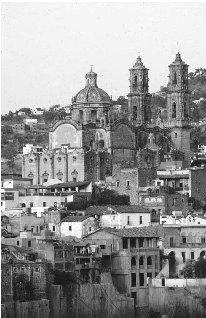
Santa Prisa Catholic Church was built in 1748.
When the Spanish arrived, they conquered the Aztec. The Spanish then replaced the Aztec in dominating the indigenous populations. In 1523, Juan Rodríguez led an expedition to the region. In 1527, Alonso de Saavedra Cerón sailed off the Pacific coast towards the Molucas Islands but his expedition never returned.
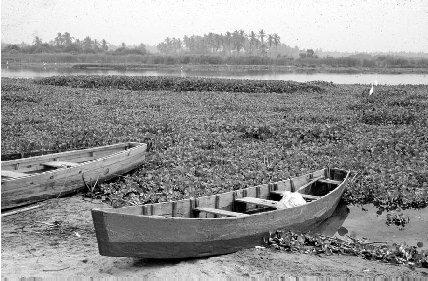
Laguna de Coyuca bird sanctuary in Acapulco.
In 1534, Spanish expeditions discovered silver in Taxco. Mineral production attracted more Spanish settlers. This radically changed the lives of indigenous communities. Trade with Asia was possible because the natural harbor at Acapulco made a great Pacific coast port. The tough and dangerous trip between Acapulco and Mexico City required twelve days to complete. But the prospects of lucrative trade routes with Asia converted it into one of the busiest colonial roads in Mexico.
Slave trade was also practiced in Acapulco during that period. Runaway slave communities formed in the mountain region and remained active until the mid-19th century. Modern-day descendants of African slaves live along the southern Pacific coast.
During the movement to gain independence for Mexico from imperialist Spain, José Morelos (1765–1815) was commissioned by Mexican priest and revolutionary Miguel Hidalgo (1753–1811) to form an independence army in Guerrero. More than three thousand soldiers joined Morelos. They liberated Chilpancingo from Spanish control and declared it the nation's capital in 1813 after the Anahuac Congress (the meeting at which regional leaders decided to fight for Mexican independence). After Morelos's death, the struggle for independence continued. Vicente Guerrero (1783–1831) emerged
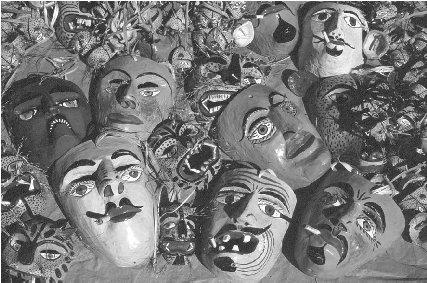
Masks used for religious festivals.
Guerrero was appointed as chief of the southern region of Mexico, where he fiercely fought for the establishment of a federal republic. The political instability in the country led Guerrero to undertake a number of armed battles. He eventually became president of Mexico in 1829 but was assassinated nine months after taking office.
Indigenous rebellions and discontent with Antonio Lopez de Santa Anna (1794–1876), who served as president of Mexico from 1833 to 1836, helped worsen the political and military instability of the region. Many constitutionalist and liberal leaders sought refuge in Guerrero and attempted to reorganize their opposition to French emperor Maximilian (1832–1867). (France had conquered and ruled parts of Mexico from 1864 to 1866.) During the Porfiriato period, when Porfirio Diáz was in power (1877–1880 and 1884–1911), conflicts between caudillo (politically powerful) leaders and military strongmen made it difficult for Guerrero to be fully controlled by the state authorities. The presence of militias and the weak state government made it easier for the Mexican Revolution to take hold in Guerrero starting in 1910.
When the revolution came to an end, the Institutional Revolutionary Party (PRI) emerged as the national political force. Allegiance to the PRI helped reduced old conflicts between local caudillo families in Guerrero. The presidency of Miguel Alemán from 1946 to 1952 helped promote economic development, particularly in Acapulco.
Widespread poverty and inequality helped fuel support for different guerrilla groups in the 1960s and 1970s. Economic development in the 1980s and the consolidation of Acapulco, Ixtapa, and Taxco as tourism attractions have benefited the economy of the state. Rural violence by insurgent groups continues in the early years of the 21st century. Guerrero is among the states with high numbers of insurgent groups operating in the countryside. Insurgents are small groups that rebel against the government, but who are not large enough or well-organized enough to carry out a revolution.
9 State and Local Government
A powerful state governor is democratically elected every six years. All governors since the end of the Mexican Revolution (1910–1920) have belonged to the Institutional Revolutionary Party (PRI). Rene Juárez Cisneros won the 1999 gubernatorial election, defeating a Party of the Democratic Revolution (PRD ) challenger. The dominance of one political party, the PRI, has made it difficult to implement separation of power and check-and-balance provisions. A unicameral (one chamber) state congress is comprised of a forty-six-member assembly. Twenty-eight representatives are elected in single member districts and eighteen by proportional representation.
Guerrero is comprised of seventy-five municipalities. Local governments in Guerrero have varying powers and attributions. Larger and more populated municipalities are more autonomous and independent of the state government. Municipal presidents and council members are elected for three-year nonrenewable terms.
10 Political Parties
The three main political parties in all of Mexico are the Institutional Revolutionary Party (PRI), the National Action Party (PAN), and the Party of the Democratic Revolution (PRD). The PRI has dominated politics in Guerrero since after the end of the Mexican Revolution. PRI governors from Guerrero have been important actors at the national level. Guerrero is one of the most populated states and a PRI stronghold. Candidates for president of Mexico seek the active support of the Guerrero governor. The PRD traces its roots to revolutionary activities of the 1960s.
11 Judicial System
A Superior Tribunal of Justice is the state's highest court. Comprised of sixteen members appointed by the governor with congressional approval, the justices can be re-appointed after their six-year terms expire. There is a mandatory retirement provision for all those age sixty-five or older. In addition, there are local and state level appeals courts as well as an electoral tribunal.
12 Economy
The state of Guerrero has diverse and abundant natural resources. Active economic sectors are farming, commerce, and
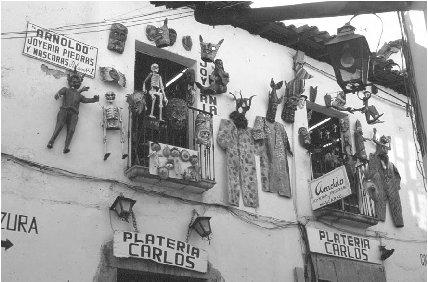
Storefronts on the Plaza Borda in Taxco.
13 Industry
Historically, Guerrero did not have much large-scale industry. The state has many small establishments, such as blacksmith shops, carpenter shops, and hat factories, all of which provide products and services to a local market. There are some manufacturing facilities that process products made from palm leaves and fibers. There are also a few assembly plants that produce clothing for export. Following the passage of the North American Free Trade Agreement (NAFTA) in 1992, many new maquiladoras assembly plants were established, especially in the northern region of the state.
14 Labor
The US Bureau of Labor Statistics reported that Mexican workers saw their wages increase 17%, from $2.09 per hour in 1999 to $2.46 per hour in 2000. (The average US worker earned $19.86 per hour in 2000.) After one year, workers are entitled by law to six days paid vacation.
15 Agriculture
The main economic activities in the valleys in the center of the state are agriculture and livestock breeding. The main agricultural products are maize (corn), beans, sorghum, rice, sesame, tomato, melon, lemon, coffee, coconuts, and bananas. Guerrero produces more than 3% of beef consumed in Mexico.
Only 10% of the cultivated land in Guerrero is irrigated.
16 Natural Resources
Taxco is in the center of the silver mining region of Mexico. Many of the forests in the inland regions have been cut down by international timber companies. In 2003, the World Bank invested in a program to help indigenous people manage the forests on their lands in Guerrero.
17 Energy and Power
The government-run Federal Electricity Commission (CFE) supplies most of Mexico's power. Unlike many states to the north where demand for power is increasing, the demand for electricity in Guerrero declined during the late 1990s, reflecting the lack of growth in population.
18 Health
There are 27 general hospitals, 1,016 outpatient centers, and 71 surgical centers in the state.
Most of the Mexican population is covered under a government health plan. The IMSS (Instituto Mexicano de Seguro Social) covers the general population. The ISSSTE (Instituto de Seguridad y Servicios Sociales de Trabajadores del Estado) covers state workers.
19 Housing
Only about one-fourth of the housing available in Guerrero is in good repair. More than 40% is in need of significant upgrading. Many homes do not have running water or access to electricity.
20 Education
The system of public education was first started by President Benito Juárez (1806–1872) in 1867. Public education in Mexico is free for students from ages six to sixteen. According to the 2000 census, there were approximately 900,000 school-age students in the state. Many students elect to go to private schools. The thirty-one states of Mexico all have at least one state university. Universidad Autonoma de Guerrero (Independent University of Guerrero) is in the capital, Chilpancingo.
21 Arts
Acapulco and Taxco both have several theaters. Many craft galleries and artisans' workshops are open to the public throughout the state.
22 Libraries and Museums
Guerrero has 145 branches of the national library system. There are forty-one museums in the state. Acapulco has a naval museum and Cuajinicuilapa has a museum of Afro-Indian (Afromestizo) culture, reflecting the culture of the state's population who trace their ancestry to former slaves. Taxco, located in the center of a silver mining region, has a museum devoted to the history of silver mining and jewelry making.
23 Media
Acapulco has three daily newspapers, including El Sol de Acapulco, El Sur, and Novedades Acapulco. An English-language daily, Acapulco Newspaper, is published for tourists, with information on shopping, dining, and other tourist attractions. In Puerto Vallarta, the newspapers are the PV Tribune and Vallarta Today.
24 Tourism, Travel, and Recreation
Acapulco is one of Mexico's oldest and best known resort areas. The city lies around the spectacular Acapulco Bay. Visitors enjoy water sports, beaches, deep-sea fishing, and golf. A tourist attraction are the cliff divers, who plunge from high rocky cliffs into deep water pools. San Diego Fort, built to defend the area against pirates, dates from 1616. Other cities that attract tourists are Ixtapa and Zihuanatejo, both of which lie on the ocean coast that become known as the Mexican Riviera (after the resort area on the south coast of France). Taxco, a colonial city located in the mountains at an altitude of 3,000 meters (6,000 feet), is famous for its hundreds of small shops that sell silver jewelry.
25 Sports
Acapulco has a bullfighting ring at the Plaza Caletilla. Acapulco's professional baseball team plays in the 13,000-seat Universidad Deportiva stadium.
26 Famous People
The state is named for Vicente Guerrero Saldaña (1783–1831), a leader in the independence movement. Poet and playwright Juan Ruiz de Alarcón (c. 1580–1639) was born in Taxco. Cuauhtémoc (c. 1495–1522), the last Aztec ruler, was hung by order of Spanish conqueror Hernán Cortés (1485–1547) and is buried in Ixcateopan.
27 Bibliography
Books
DeAngelis, Gina. Mexico. Mankato, MN: Blue Earth Books, 2003.
Supples, Kevin. Mexico. Washington, DC: National Geographic Society, 2002.
Vincent, Theodore G. The Legacy of Vicente Guerrero: Mexico's First Black Indian President. Gainesville, FL: University Press of Florida, 2001.
Web Sites
Mexico for Kids. http://www.elbalero.gob.mx/index_kids.html (accessed on June 11, 2004).
Surfing & Adventure Travel in Mexico: The State of Guerrero. http://www.surf-mexico.com/states/Guerrero/ (accessed on June 17, 2004).